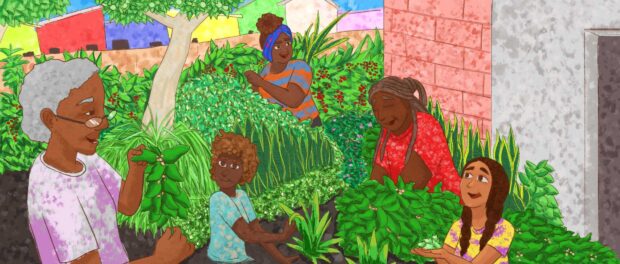
This article is the latest contribution to our year-long reporting project, “Rooting Anti-Racism in the Favelas: Deconstructing Social Narratives About Racism in Rio de Janeiro.” Follow our Rooting Anti-Racism in the Favelas series here.
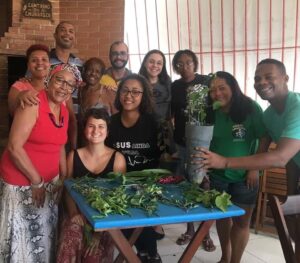 Willows are lovely trees. This is not why the carioca favela is so named, but it makes total sense all the same. Morro do Salgueiro (Willow Hill), in the North Zone of the city, has a fertile environment where women from the community joined as a group of herb growers. During the Favela-Bairro favela upgrading program, many herbs that sprouted naturally, and that were also grown for medicinal and culinary uses, were pulled up to make way for tarmacking roads and buildings sidewalks. In response to this small deforestation, in 2019 some residents saw it necessary to protect and learn more about the diverse species of flora in Salgueiro. To achieve this, the “tias” (“aunties”), as they are called in the community, relied on the help of doctors from the Heitor Beltrão Municipal Health Center to collect technical information about the benefits and properties of every herb that grows on the hill.
Willows are lovely trees. This is not why the carioca favela is so named, but it makes total sense all the same. Morro do Salgueiro (Willow Hill), in the North Zone of the city, has a fertile environment where women from the community joined as a group of herb growers. During the Favela-Bairro favela upgrading program, many herbs that sprouted naturally, and that were also grown for medicinal and culinary uses, were pulled up to make way for tarmacking roads and buildings sidewalks. In response to this small deforestation, in 2019 some residents saw it necessary to protect and learn more about the diverse species of flora in Salgueiro. To achieve this, the “tias” (“aunties”), as they are called in the community, relied on the help of doctors from the Heitor Beltrão Municipal Health Center to collect technical information about the benefits and properties of every herb that grows on the hill.
Since then, the Salgueiro Herb Growers Group has been meeting in the traditional Caliel Bakery: a family bakery which opened in the 1990s, where the parents of Marcelo da Paz—today manager of the establishment—made bread at home without any machinery. The dough, made of wheat and yeast, was prepared in a big basin, which the owners would take out into the small alleyways and narrow streets filled with their breads and cakes to sell to residents. The Caliel Bakery became a social hub which embraces the community’s culture.
Before the pandemic, the herb growers held monthly meetings, but due to the coronavirus pandemic, the bakery stopped hosting get-togethers. Now, they are planning to start the meetings up again, following the necessary social distancing measures. For the time being, members have continued to communicate virtually, but the group is determined. Thinking about starting a dialogue with new generations, their objective is to catalogue the herbs spread around the favela.
 Denise Vieira, known as “Environmental Denise,” is one of the founders of the Salgueiro Herb Growers Group. She explains: “I joined the group because of my mother, who was a descendent of Brazil’s indigenous population. She was from Olinda, in Pernambuco state. There were lots of herbs in our garden that always healed us. In one part of the community, there is an orchard with species native to the Atlantic Forest. I took children and adults there to replant trees. Fruit trees don’t just feed the fauna, they also feed us, and they all have medicinal properties. Here, we are a buffer zone of the Tijuca National Park. The herbs and plants are beings that have souls too. The lesson is that we won’t have a good quality of life without them. Herbs are not only able to generate income, but also wellbeing.
Denise Vieira, known as “Environmental Denise,” is one of the founders of the Salgueiro Herb Growers Group. She explains: “I joined the group because of my mother, who was a descendent of Brazil’s indigenous population. She was from Olinda, in Pernambuco state. There were lots of herbs in our garden that always healed us. In one part of the community, there is an orchard with species native to the Atlantic Forest. I took children and adults there to replant trees. Fruit trees don’t just feed the fauna, they also feed us, and they all have medicinal properties. Here, we are a buffer zone of the Tijuca National Park. The herbs and plants are beings that have souls too. The lesson is that we won’t have a good quality of life without them. Herbs are not only able to generate income, but also wellbeing.
The objective of the Salgueiro Herb Growers Group is to champion and keep alive the memory of the favela’s matriarchs. They want to show everyone the potential in the gardens of their houses and in the forests that surround the favela. Food sovereignty is also a discussion point at meetings. Denise Vieira says: “My mother died at the age of 94, she made her living running a daycare center and she looked after the children with herbs from our garden. The daycare was in our house. There were no public policies for daycare centers in favelas in 1969. My mom used rope tobacco with alcohol to get rid of everyone’s lice. We used powdered charcoal as toothpaste to clean our teeth. Lady’s thumb to treat itchiness. Brazilian peppertree made into tea for bathing, to treat mosquito bites. Job’s tears to help mothers giving birth. We had a chicken coop and we fed the roosters and chickens leaves. We even have a hundred-year-old abiu tree (pouteria caimito), a species from the Amazon with numerous medicinal properties. And tea made from the leaves of guava trees to treat diarrhea. Lemon juice with corn starch is used to clean out the intestine. Back then, we couldn’t get our hands on so many brands of soft drinks. Children were healthier because the food was natural.”
In December 2020, the National Inquiry into Food Insecurity and Covid-19 in Brazil carried out a survey in 2,180 homes in urban areas in the country’s five regions. The results showed that in 55.2% of homes the occupants live with food insecurity. Only 44.8% of homes were food secure.
The herb growers’ mission is to protect and make use of all the vegetables spread around the favela. Denise Santos, coordinator of the Jurema Batista Library, located at the Se Liga Salgueiro Radio, reflects: “One day, I was at the top of the hill and there was a whole wall covered in peppermint. I was impressed by such a large quantity of the plant being there. Working with plants only brings us love. We learn more about them every day. Sometimes we are in the middle of a path and we don’t even know the name of the plant. At the moment, I am renovating my vegetable garden, but I already have basil, assa-peixe (vernonia polysphaera), guaco (mikania glomerata spreng)… They are slowly arriving, ready to be planted in a specific place and it’s the residents who are donating them. One of these days someone brought me saião (kalanchoe brasiliensis cambess). We can only combat global warming if we plant trees, reduce slash-and-burn agriculture. We need to plant in flowerpots, in vegetable gardens, everywhere, to combat global warming and global hunger, which is the most cruel face of environmental racism.”
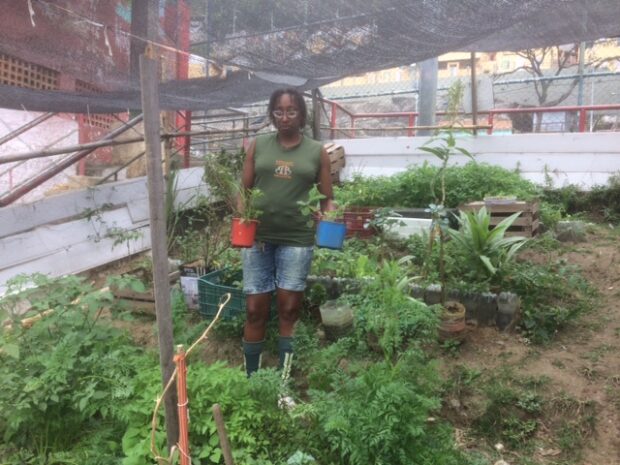 Most of the herb growers are over 60, so the group is mostly made up of people who are at higher risk of coronavirus infection. For this reason, the group decided to move all their discussions to WhatsApp, to respect the necessary social isolation. Reminiscing on when she joined Salgueiro Herb Growers Group, the strong in-person characteristic of the project before the pandemic and how they kept their activities going, albeit remotely, Denise Santos says: “I joined Salgueiro Herb Growers Group because of the Atitude vegetable garden, which I look after in Salgueiro. I planted herbs there and, seeing this, the group asked me to be an herb grower. The community’s ancestry fascinates me. In the past, everyone looked after themselves with herbs. My father planted many of these herbs when he arrived in the community, but with paved pathways and bridges, many got lost. The group came to rescue this herb culture. We were at a bit of a standstill and the first in-person meeting during the pandemic was in March of this year. It is a question of preservation since almost all the species are dying out. So we only find some in the forest because they already grow naturally in the middle of rocks. Plants bring great joy, and not just in vegetable gardens, but also in their medicinal form like lemon balm and peppermint. I learned a lot with this group.”
Most of the herb growers are over 60, so the group is mostly made up of people who are at higher risk of coronavirus infection. For this reason, the group decided to move all their discussions to WhatsApp, to respect the necessary social isolation. Reminiscing on when she joined Salgueiro Herb Growers Group, the strong in-person characteristic of the project before the pandemic and how they kept their activities going, albeit remotely, Denise Santos says: “I joined Salgueiro Herb Growers Group because of the Atitude vegetable garden, which I look after in Salgueiro. I planted herbs there and, seeing this, the group asked me to be an herb grower. The community’s ancestry fascinates me. In the past, everyone looked after themselves with herbs. My father planted many of these herbs when he arrived in the community, but with paved pathways and bridges, many got lost. The group came to rescue this herb culture. We were at a bit of a standstill and the first in-person meeting during the pandemic was in March of this year. It is a question of preservation since almost all the species are dying out. So we only find some in the forest because they already grow naturally in the middle of rocks. Plants bring great joy, and not just in vegetable gardens, but also in their medicinal form like lemon balm and peppermint. I learned a lot with this group.”
We Have Come a Long Way
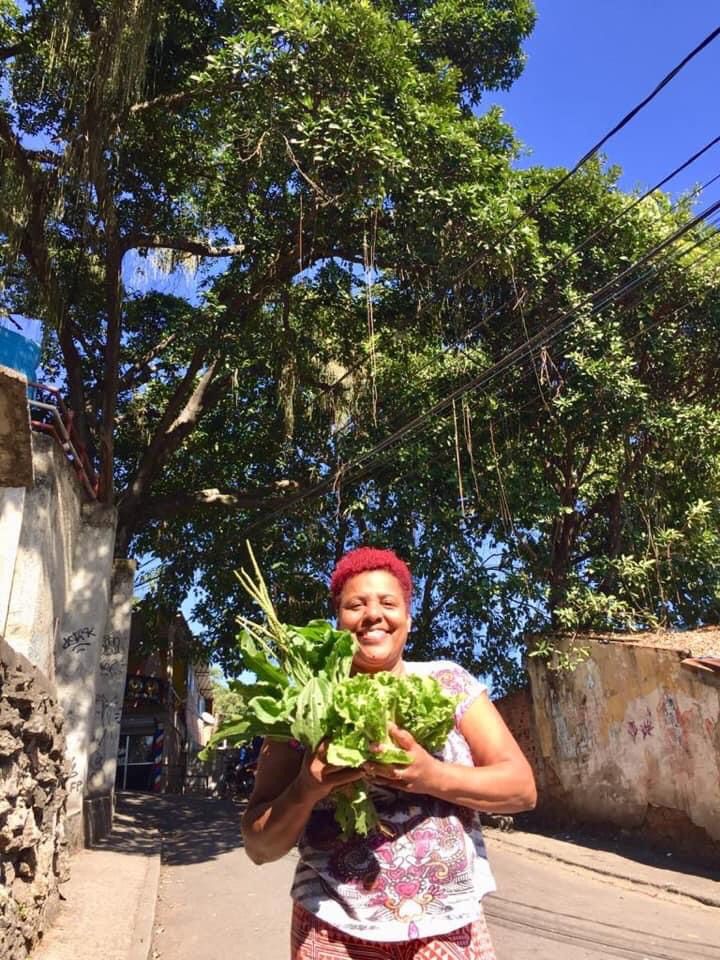 Salgueiro is known for the traditional Acadêmicos do Salgueiro Samba School. But it’s not just samba and its great living symbols that make up the long trajectory of this community in Tijuca. It was founded in 1885 with the arrival of former workers from the coffee plantations of the Paraíba Valley, located between the cities of São Paulo and Rio de Janeiro, and its neighboring areas. At the end of the 19th Century, Salgueiro was still part of Chácara do Trapicheiro. Salgueiro was given its name in the mid-1920s because the Portuguese trader Domingos Alves Salgueiro, who owned 30 buildings in the community, became a local reference. And so the hill came to be known as “Morro do seu Salgueiro” (Mr. Salgueiro’s Hill).
Salgueiro is known for the traditional Acadêmicos do Salgueiro Samba School. But it’s not just samba and its great living symbols that make up the long trajectory of this community in Tijuca. It was founded in 1885 with the arrival of former workers from the coffee plantations of the Paraíba Valley, located between the cities of São Paulo and Rio de Janeiro, and its neighboring areas. At the end of the 19th Century, Salgueiro was still part of Chácara do Trapicheiro. Salgueiro was given its name in the mid-1920s because the Portuguese trader Domingos Alves Salgueiro, who owned 30 buildings in the community, became a local reference. And so the hill came to be known as “Morro do seu Salgueiro” (Mr. Salgueiro’s Hill).
Then, the first inhabitants started arriving from the south of Bahia, from the Northeast in general, and from the interior of Rio de Janeiro and Minas Gerais. Following the ancestry passed onto her by her grandmother, Tânia Cristina, 54, explains how she started growing herbs: “My grandmother was from Minas and she was the daughter of slaves. She already came here with the experience of that era. My granny taught me to know a plant by its smell. I often see a plant and I don’t know what it is, but then I rub it on my hands, smell it and the name of the plant soon comes to mind. When I lived with her, we didn’t have much pharmaceutical medicine and we used Brazilian cherry, St John’s-wort and wild pansy. The years went by, and [as] I am also a Candomblé practitioner, herbs entered my life for real. I’ve always had a special gift with herbs. I have always really liked plants because my grandmother and my mother always showed us their power. 25 years ago, I trained as a nurse and it greatly sharpened my curiosity for using plants to heal. I don’t like pulling up plants. Sometimes I find a plant in the street, I pick it up and I plant it here at my house. My son said that someday he’ll have to leave to make space for the plants. I said: ‘suit yourself.’ I make lots of syrups for my grandchildren Arthur, Nathália and Maurício. I have looked after them since they were little. When everyone here is really anxious, I go to my lemon balm plant and make some tea. There are so many bushes that we forget about today.”
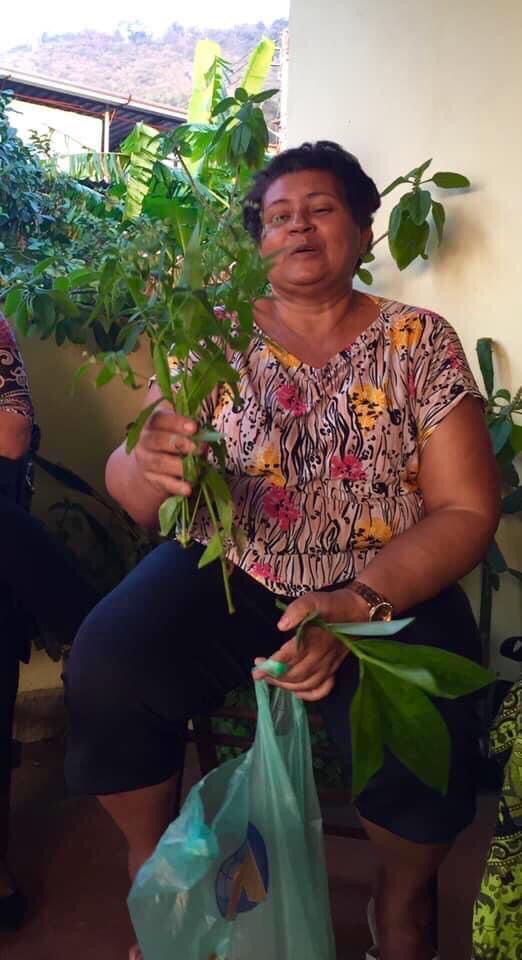 After Providência, Salgueiro is one of Rio’s oldest favelas. It was there that the first residents’ association in the city was established. In 1934, the then 7,000 residents of Salgueiro were threatened with eviction, but led by samba musician Antenor Gargalhada [the resident’s association] left the judicial hearing victorious. Many of their descendants live in Salgueiro even today.
After Providência, Salgueiro is one of Rio’s oldest favelas. It was there that the first residents’ association in the city was established. In 1934, the then 7,000 residents of Salgueiro were threatened with eviction, but led by samba musician Antenor Gargalhada [the resident’s association] left the judicial hearing victorious. Many of their descendants live in Salgueiro even today.
Long-time herb grower Janaína Soares says that it was through her father that she became fascinated by the environment: “My father was part of the first community residents’ association and I learned a lot about herbs [from him]. My father was a spiritual practitioner and he knew so much about herbs because of his mother. During my childhood, and when my children were young, we turned to herbs out of necessity, when we had fevers and colds. This was how we came to know what was good for our health. I use [this] knowledge to this day. My middle son had bronchitis and my grandmother didn’t even need to ask: I’d just bring her the herbs. During my childhood, everything was more difficult and our grandparents used herbs all the time. Things were free from pesticides. I think it’s a shame that children don’t have much contact time to learn about nature. It’s up to every adult to encourage children to plant, to put their hands in the earth, to get involved with nature. This catches their attention so that they start to take an interest in and learn about the power of herbs.”
The Salgueiro Herb Growers Group also has men in its original formation. Gender issues and latent ancestry are central to the work of black women in the favela. As part of the Hortas Cariocas municipal program network, the team’s next steps are to take the techniques for growing and harvesting, and everything involving the environment, to other favelas, to set up an herbarium and to resume meeting in person.
Reopening with Environmental Awareness Post-Vaccination
About returning to in-person meetings, Janaína Soares said: “The type of work that we do with our Herb Growers Group is a very good exchange of experiences, a way of helping other people who sometimes need a homemade remedy. We never reject mainstream medicine. On the contrary, we encourage people to go to the doctor. The group made us start new friendships… Friendship strengthened our connection. I can’t wait to get back to our meetings in person, [which] are a very important exchange of ideas and also a moment for relaxing and listening to each other… I hope that people become more interested in the power of herbs after the pandemic. During the pandemic, I myself used ora-pro-nóbis (pereskia aculeata) to strengthen my body. I believe that people are going to value nature a bit more after the pandemic. Our work is not only very important within the community, but also for trying to spread this planting and knowledge to other places. It is beautiful when someone is curious enough to pick a little plant and ask what it is. I see the herb growers’ work as an aspiration to not lose the delights of nature. I hope it passes on to other communities. I ask that people plant more and more! So that, in the future, we come to benefit from planting. Planting is excellent for our planet.”
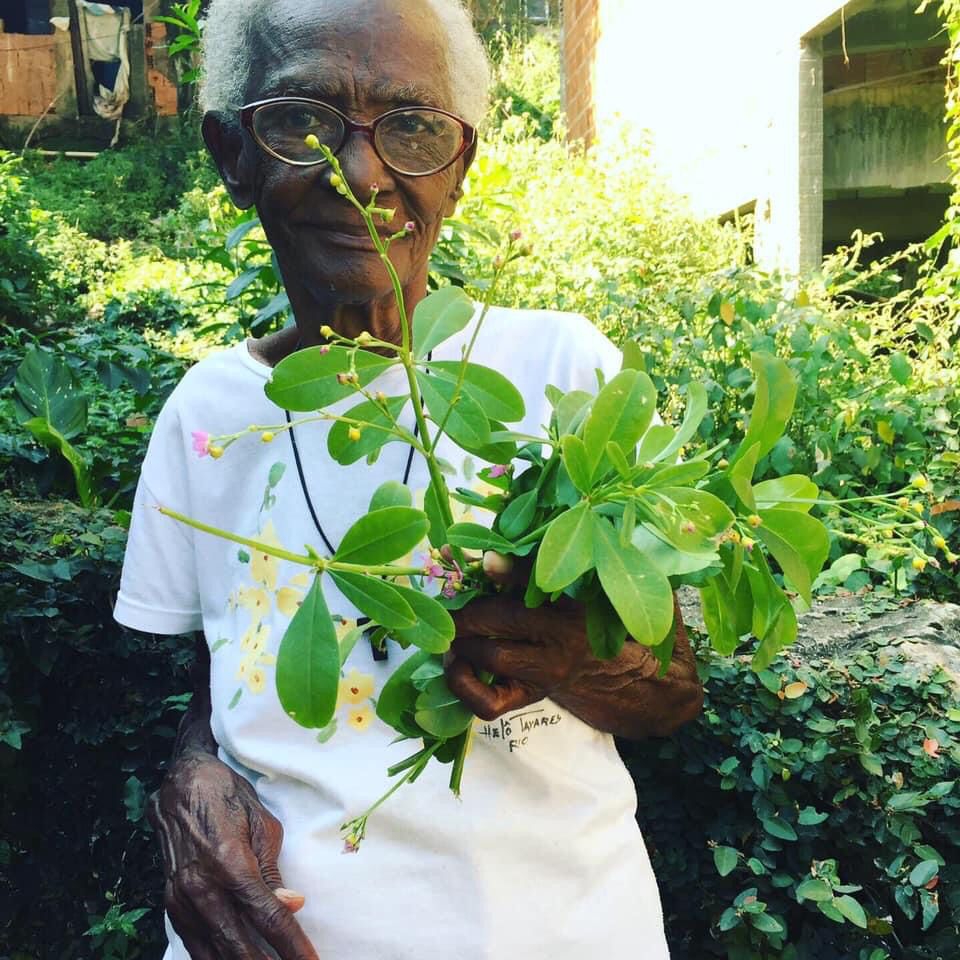 Following the same line of thought, Tânia Cristina is concerned about the climate crisis which is devastating continents, and fears for the quality of life on the planet for future generations: “I am aware that nature works in our favor and also against us when we treat it badly. God gave us everything for free and men want to take advantage by putting prices [on everything] and charging for plants and vegetables that should be free, and they still shove it in people’s faces. Covid-19 came to prove that nature is in charge, it’s not human beings [in charge]. We are here in passing and we are destroying the environment that we should be leaving for future generations. [The pandemic is] a way for nature to complain about our lack of care for her. I really want people to show more love, to see eye to eye more often, because without nature we are nothing. We are nothing without sun, without rain, without wind. They are the very elements that let us breathe, be healthy and go forward in life.”
Following the same line of thought, Tânia Cristina is concerned about the climate crisis which is devastating continents, and fears for the quality of life on the planet for future generations: “I am aware that nature works in our favor and also against us when we treat it badly. God gave us everything for free and men want to take advantage by putting prices [on everything] and charging for plants and vegetables that should be free, and they still shove it in people’s faces. Covid-19 came to prove that nature is in charge, it’s not human beings [in charge]. We are here in passing and we are destroying the environment that we should be leaving for future generations. [The pandemic is] a way for nature to complain about our lack of care for her. I really want people to show more love, to see eye to eye more often, because without nature we are nothing. We are nothing without sun, without rain, without wind. They are the very elements that let us breathe, be healthy and go forward in life.”
About the author: Beatriz Carvalho is a journalist, media-activist, feminist, and founder of Mulheres de Frente, born and raised in Vilar dos Teles, São João de Meriti.
About the artist: Anna Paula Rodrigues is a freelance designer and illustrator with a degree in industrial design from the Federal University of Rio de Janeiro (UFRJ). Anna Paula—who focuses on anti-racist topics relating to aesthetics and beauty—works as a graphic designer in numerous Rio de Janeiro NGOs.
This article is the latest contribution to our year-long reporting project, “Rooting Anti-Racism in the Favelas: Deconstructing Social Narratives About Racism in Rio de Janeiro.” Follow our Rooting Anti-Racism in the Favelas series here.
